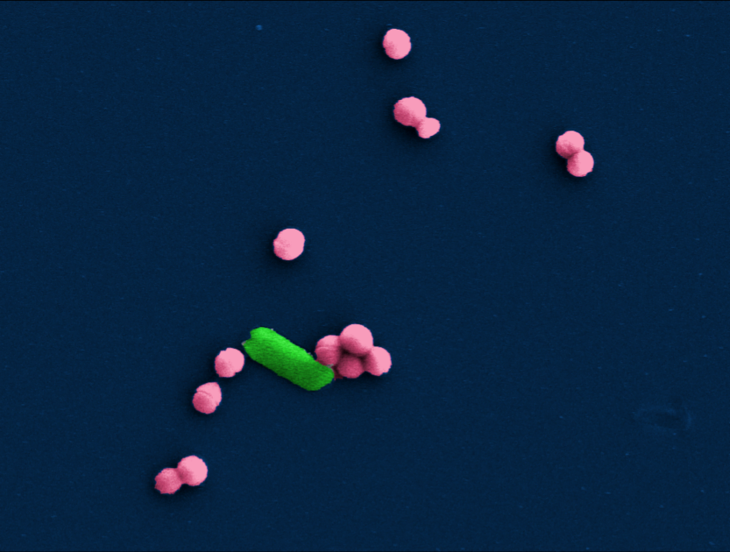July

Scientists develop device to detect bacteria in minutes
A scanning electron micrograph of a polymicrobial sample with E. coli (rod-shaped) and S. aureus (spherical). By developing a single cell analysis technique, the research team demonstrates rapid classification of the bacteria and determination of their antibiotic resistance profiles.
[IMAGE Courtesy: Wong Lab / Penn State]
Rapid bacterial analysis and testing for antibiotic sensitivity
The era of doctors prescribing patients powerful antibiotics while they wait for lab reports could soon be numbered, with a new device returning results within minutes instead of days. It was invented by a team at Penn State university.
Medical professionals may soon be able to detect bacteria in patient samples in minutes rather than days thanks to a new approach that traps and tests single cells, according to a team of biomedical engineers.Currently, testing for pathogenic bacteria takes from three to five days, so physicians often treat patients initially with broad spectrum antibiotics rather than targeting specific microorganisms. They typically may not know whether the bacteria they are trying to kill are resistant to the antibiotics they might choose.
“Multidrug-resistant pathogens are common causes of patient morbidity and mortality,” said Pak Kin Wong, professor of biomedical engineering and mechanical engineering, Penn State. “Without a rapid method of microbiological analysis, physicians are often required to prescribe antibiotics empirically, using the worst-case assumption of the most severe bacteria.”
Wong and his team created a device, using microchannels, that captures individual bacteria cells and lowers the microchannel ceiling until the bacterium is trapped. Microscopy can then determine the shape of the bacteria. Because bacteria come in three main shapes — spherical, rod-shaped, and spiral — this step not only shows that bacteria are present in the sample but begins to classify them.
“Urinary tract infections are the most common bacterial infections,” said Wong. “However, over 75 percent of urine specimens sent to a clinical microbiology laboratory are negative. Rapidly ruling out or confirming the presence of bacteria at a clinically relevant concentration will dramatically enhance patient care.”
After finding bacteria is present, the sample is exposed to antibiotics and the researchers then monitor bacterial growth. If the bacterium continues to grow after exposure, that strain is considered resistant to that antibiotic, but if the bacterium ceases to grow or dies, then the strain is not resistant, and the infection can be treated using a single, targeted antibiotic.
The researchers report in a recent issue of the Proceedings of the National Academy of Sciences, that the combination of microchannel trapping and antibiotic exposure “rapidly determines the existence of bacteria, classifies major classes of bacteria, detects polymicrobial samples and identifies antimicrobial susceptibility directly from clinical samples at the single cell level.”
The system is 100 percent sensitive to the presence of bacteria and will classify bacteria about an 83 percent of the time. It also achieved 100 percent agreement in identifying bacteria that are antibiotic resistant. The adaptable, microchannel cell-trapping device is manufactured by molding, and according to Wong can be manufactured economically at production scale. He is currently working with GE Global Research to develop a benchtop version of the entire system for potential use in clinics, pharmacies, emergency rooms and physicians’ offices. The microfluidic chip on which the analysis will be conducted will be disposable.
“This is similar to a printer and printer cartridges,” said Wong. “We are also exploring the feasibility of developing a portable or handheld version of the system for other applications, such as field testing, nursing homes and rural clinics.”
The researchers have a provisional patent. Other Penn State researchers working on this project include Hui Li, graduate student in biomedical engineering; Peter Torab, graduate student in mechanical engineering; Matthew England, postdoctoral scholar in pathology; David Craft, professor and interim chair of pathology; and Neal Thomas, professor of pediatrics and public health sciences, and associate dean for clinical research. Also working on the project were Joseph Liao, associate professor, and Kathleen Mach, research associate, urology, Stanford University School of Medicine; and Christine Surrette and Chris Puleo of GE Global Research. The Defense Threat Reduction Agency and the National Institutes of Health supported this work.
[Reference: https://news.psu.edu/story/572764/2019/05/06/research/rapid-bacterial-analysis-and-testing-antibiotic-sensitivity




Leave a Reply